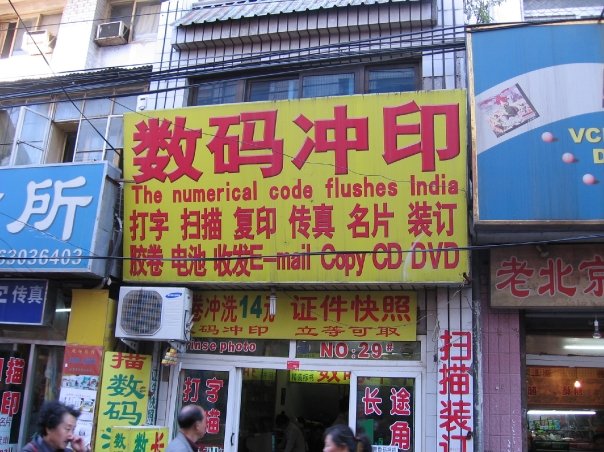China flushes India
« previous post | next post »
The following photograph of a Beijing shop sign was buried on my desktop for about five years (I think that it originally came to me from Ori Tavor):
Here's what it really says:
shùmǎ chōngyìn 数码冲印 ("digital printing")
What? How did they so badly mangle those two words that most people in China know the meaning of and use regularly?
Simple: they just looked up shùmǎ chōngyìn 数码冲印 on iCIBA and iCIBA told them it means "The numerical code flushes India". (N.B.: all the other main online translation services — Google Translate, Bing Translator, and Baidu Fanyi — get it right.)
But how did iCIBA (or whoever they got it from) come up with such an outlandish translation?
Simple, they just took the most common meanings for the four individual characters used to write the two words, instead of looking up the words:
shù 数 ("number; numerical")
mǎ 码 ("code")
chōng 冲 ("flush" — the word for "develop a photographic print" is chōngxǐ 冲洗 ["flush-wash"])
yìn 印 ("India" [first syllable of the Mandarin transcription "Yìndù 印度"]; original meaning is "seal; stamp; mark; impress; print" — used here only for its sound)
chōngyìn 冲印 is short for "develop and print"; now, with digital photography, it is no longer necessary to flush-wash film before printing, but the Chinese retain the old terminology for the new technology
Oh, the perils of ignoring words in favor of characters!

flow said,
January 15, 2015 @ 6:34 am
To be fair to the translation service, the full information for 数码冲印 on iCIBA runs
PRINTS; The numerical code flushes India; digital photo printing; Digital Minilab
so whatever the merits of these choices are, whoever produced the shop sign managed to pick the most hilarious one. The really astounding thing is that the alternatives have words like "digital", "print", "photo" in them, while the odd man has "India"—one would assume that even with minimal understanding, *one* of these very 'international' words should have triggered a more thoughtful choice.
Then again, the translation on the sign is unlikely, but not impossible, is it? Quick, what does 中貝建交 mean?
Victor Mair said,
January 15, 2015 @ 8:09 am
@flow
Taken completely out of context the way you have presented it, my immediate interpretation of Zhōng-Bèi jiànjiāo 中貝建交 would be "China and Benin establish diplomatic relationships". That would hold whether it's the People's Republic of China, which uses Bèiníng 贝宁 to refer to Benin, or the Republic of China, which uses Bèinán 貝南. Since you have written Zhōng-Bèi jiànjiāo 中貝建交 with simplified characters, I suppose that you're referring to the Republic of China on Taiwan.
Aside from "China and Benin establish diplomatic relationships", what other translation of zhōng bèi jiàn jiāo 中貝建交 were you thinking of?
flow said,
January 15, 2015 @ 11:19 am
@VHM "what other translation of 中貝建交 were you thinking of?"—specifically one including 貝里斯 Belize which is what i seem to remember; Wikipedia: "1989年10月13日,貝里斯宣布和中華民國建立外交關系。" I was in Taiwan during that time, standing in front of a newsstand or somesuch and trying hard to make any sense out of the four-character headline. I couldn't but the following article made it clear. I was quite impressed at the terseness and semantic versatility of the writing.
Being able to parse such phrases is to no small part the result of a long experience with the language as such and with the text genre in question (headlines and shop signs being the examples here). Sometimes when it gets difficult you can almost *watch* yourself running down the gardenpaths and backing up. In the case of the headline, it tremendously helps to know 建交; in case you don't, there must be a lot of whacky attempts including words like 建國, 建築, 建設, 交通, 交流 and so on. As for 中貝, "hit a shell" (??) may be a guess.
In this case of the shop sign, someone/thing opted for 冲洗印度 or similar, but then the translation request comes with zero context. Here in Berlin many shop signs have "Backshop" written on them (the first part is G. for baking bread, not E. back (-wards)); in Taiwan, where shop signs run RTL as often as LTR or top-bottom you have to prepare for shops that sell 皮包 in the unexpected direction. I mean, short signs can be hard to read!
"Zhōng-Bèi jiànjiāo 中貝建交 with simplified characters, I suppose that you're referring to the Republic of China on Taiwan"—no difference here between 'simplified' and 'traditional' here, i think?
Victor Mair said,
January 15, 2015 @ 12:40 pm
@flow
The bèi 贝 is different in simplified.
flow said,
January 15, 2015 @ 5:04 pm
you're right. missed that one.